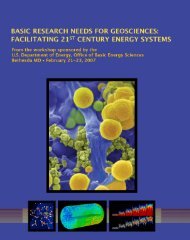Cyber Physical Systems â Situation Analysis - Energetics Meetings ...
Cyber Physical Systems â Situation Analysis - Energetics Meetings ...
Cyber Physical Systems â Situation Analysis - Energetics Meetings ...
- No tags were found...
You also want an ePaper? Increase the reach of your titles
YUMPU automatically turns print PDFs into web optimized ePapers that Google loves.
<strong>Cyber</strong> <strong>Physical</strong> <strong>Systems</strong> – <strong>Situation</strong> <strong>Analysis</strong>DRAFT – March 9, 2012increased use of renewable energy to generate electricity accounts for 33% of overall growth between2010 and 2035 due to various federal and state policies and requirements. 92The current level of electricity demand has a significant effect on energy-related carbon dioxide emissionssince a large portion of electricity is generated from coal. Electricity generation in the United States isresponsible for 40% of human-caused carbon dioxide emissions. 93 Concerns about greenhouse gasemissions are moving electricity generation away from coal. With the projections of increased use ofrenewable energy and modest growth in demand, electricity-related carbon dioxide emissions will grow4.9% between 2010 and 2035. 94 CPS can help to reach these projections of slowing the rise of carbondioxide emissions as demand for electricity increases.As more consumers begin to use electric vehicles, the smart grid will have to adapt to increased loads aswell as being able to integrate these vehicles as part of the grid. These vehicles will provide bothopportunities and challenges as to how the smart grid can provide charging when necessary or even usethe vehicles as storage when possible. CPS engineering and advancements in smart transportation willthus affect those in the smart grid, allowing for innovation in function and capability in both energy andtransportation systems. 95 Integrating electric vehicles into the smart grid will also help reduce the numberof gasoline-powered vehicles that contribute to emission. 96CURRENT STATE OF THE TECHNOLOGYThe U.S. electric power grid is a large, complex ―system of systems.‖ Power generation, transmission,and distribution systems operate on local, regional, and national levels. The entire grid consists of threeinterconnected networks divided into 152 regional control areas. 97 The grid encompasses 3,200 electricutility companies, 17,000 power plants, and covers six million miles of distribution lines. 98 Although thecomplicated system is dependable and effective, many improvements can be made using the applicationof CPS to develop a more efficient, reliable smart grid.The electric grid today is driven by consumer demand—and it is generated as it is consumed. Electricitycannot be stored easily or economically, leading to little storage capacity for producers. The currentsystem of managing generation while responding to demand is inefficient for generation systems today,especially when the systems are unable or slow to switch on or off in response to demand. 99 Control inpower plants is primarily used to ensure that there is stability during normal operation. Each utilitycompany uses automatic generation control (AGC) to regulate power imbalances that are not easilypredicted, yet there is no online coordination between the utilities. 100 Control mechanisms for power floware inefficient and expensive and do not allow for flexible routing of power flow. 101 If the system couldpredict or model future demand using CPS engineering and technologies, providers would be able tobetter prepare for peak loads without overestimating them.92 U.S. Energy Information Administration (EIA). Annual Energy Outlook 2012 Early Release Overview. 2012.93 Arnold, George W. NIST presentation: Overview of NIST’s Smart Grid Program. 2011.94 U.S. Energy Information Administration (EIA). Annual Energy Outlook 2012 Early Release Overview. 2012.95 NITRD. Winning the Future with Science and Technology for 21 st Century Smart <strong>Systems</strong>. 2011.96 EPRI. Report to NIST on the Smart Grid Interoperability Standards Roadmap. 2009.97 Adam, Nabil. DHS. Workshop on Future Directions in <strong>Cyber</strong>-<strong>Physical</strong> <strong>Systems</strong> Security. 2010.98 Arnold, George W. NIST presentation: Overview of NIST’s Smart Grid Program. 2011.99 NITRD. Winning the Future with Science and Technology for 21 st Century Smart <strong>Systems</strong>. 2011.100 Ilic, Marija. Complex Power Grids: From Grid-Centric Reliability to Meeting Grid-enabled Users Needs. Presentation at2011 CPS PI Meeting.101 Krogh, Bruce et al. National Workshop on Beyond SCADA: NEC4CPS. 2007.19
















